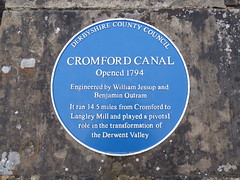Cromford Canal
Commemorated on 1 plaque
Cromford Canal Opened 1794 Engineered by William Jessop and Benjamin Outram It ran 14.5 miles from Cromford to Langley Mill and played a pivotal role in the transformation of the Derwent Valley.
High Peak Junction, Cromford Hill, Cromford, United Kingdom where it sited


